Honeywell Home is a system partner for heating systems you can rely on. Our innovative and high-quality products enable solutions from a single source and have long provided high levels of customer satisfaction.
Central heating - two-pipe system
System description
Two-pipe systems for distributing heat are most common in Europe. The radiators are connected in parallel and supplied with the same flow temperature by means of supply and return pipes. In modern buildings, heat distribution is horizontal: each apartment is supplied by a dedicated section. In pre-existing systems, on the other hand, vertical distribution is common, with supply and return lines running through multiple floors.
Hydronic balancing
For modern two-pipe systems with speed-regulated pumps, hydronic balancing using automatic differential pressure controllers is recommended. These ensure constant, pre-set pressures and, in combination with adjustable thermostatic valves, also ensure the correct, consumer-specific flow and thus the correct distributionof heat. This maximises convenience and energy savings.
Dynamic solutions:
Automatic differential pressure regulators Kombi-Auto and Kombi-3-Plus with membrane regulator for applications from DN10 to DN100

Kombi-Auto
Kombi-S

Kombi-3-Plus Red
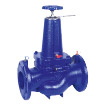
Kombi-Auto
Static solutions:
Static balancing valves for applications from DN10 to DN400
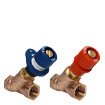
Kombi-3-Plus Blue
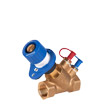
Kombi-2-Plus

Kombi-F

Kombi-Auto
Kombi-S

Kombi-3-Plus Red

Kombi-Auto

Kombi-3-Plus Blue

Kombi-2-Plus

Kombi-F
Central Heating – heat interface units
System description
Central heating systems equipped with local heat interface units are in principal comparable to two-pipe systems. Radiators connected in parallel or heating circuits in panel heating are supplied with the same flow temperature via supply and return pipes. Heat interface units contain all the components for combined local water heating and hot water distribution and for horizontal distribution of the heating water to individual apartments.
Hydronic balancing
As in modern two-pipe systems with speed-regulated pumps, hydronic balancing using automatic differential pressure controllers is recommended. These ensure constant, pre-set pressures and, in combination with adjustable thermostatic valves, also ensure the correct, consumer-specific flow and thus the correct distribution of heat. In the case of applications with heat exchange units, the differential pressure controller on the primary side should be arranged upstream of these heat exchange units so that the generation of heat for hot water is also balanced.
Dynamic solutions:
Automatic differential pressure regulator Kombi-Auto for applications from DN10 to DN100. Alternatively: Kombi-QM

Kombi-Auto
Kombi-S

Kombi-3-Plus Red
Static solutions:
Static balancing valves for applications from DN10 to DN400
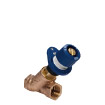
Kombi-3-Plus Blue

Kombi-Auto
Kombi-S

Kombi-3-Plus Red

Kombi-3-Plus Blue
Central heating - One pipe system
System description
One-pipe systems for heat distribution are still widespread in existing building stock in Europe in some regions. The radiators are connected one after the other in series and are each supplied with a proportion of the heating water. The majority of the circulating heating water bypasses the respective radiator on a bypass circuit so that it can be mixed with the cooled water from the radiator downstream of that radiator. The flow of mixed water is then fed to the next radiator in the circuit. As a result, all the radiators in a one-pipe system have different flow temperatures dictated by the system. One-pipe systems can have a horizontal or vertical network architecture.
Hydronic balancing
For modernised one-pipe systems with a constant flow, hydronic balancing by means of automatic flow controllers or return-temperature-flow-controlled, pressure-independent control valves is recommended. Flow controllers ensure defined flow in radiator groups arranged horizontally or vertically. Return-temperature flow-controlled, pressure-independent control valves enable defined return flow temperatures when the heating system is operated in design mode or under partial load. Thermostatic valves with distribution ensure correct flow at the radiator and thus correct distribution of heat.
Dynamic solutions:
Volume flow regulator Kombi-VX and backflow-controlled pressure-independent control valves Kombi-QM with thermostat Thera-2080-WL for applications from DN15 to DN25
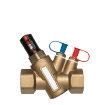
Kombi-VX

Kombi-QM mit
Thera-2080-WL
Static solutions:
Static balancing valves Kombi-3-Plus and Kombi-2-Plus for applications from DN10 to DN25

Kombi-3-Plus Red

Kombi-2-Plus

Kombi-VX

Kombi-QM mit
Thera-2080-WL

Kombi-3-Plus Blue

Kombi-2-Plus
Fan coil -two-conductor system
System description
Two-conductor systems with local fan coils as heat exchangers are in principle realised as a two-pipe system. All fan coils connected in parallel are supplied with heating or cooling at the same flow temperature via supply and return pipes. The switch from heating to cooling operation and vice versa is carried out centrally. Fan coils are usually used to supply heating or cooling room by room. The cooling or heating is fed to the room using temperature-controlled air by means of heat exchangers and fans. Engineered control is on a room-byroom or group-by-group basis using room thermostats or by incorporation in the building automation system.
Hydronic balancing
As in modern two-pipe systems with speed-regulated pumps, hydronic balancing using automatic differential pressure controllers in the pipes/circuits is recommended. These ensure constant, pre-set pressures and, in combination with adjustable control valves with actuation at the fan coil, also ensure the correct, consumer specific flow and thus the correct distribution of heat. Alternatively, hydronic balancing in modern systems is carried out on a consumer-specific basis with pressure-independent control valves and actuators at the fan coil. It is also recommended that pre-control be carried out in this case using automatic differential pressure controllers.
Dynamic solutions:
Automatic differential pressure regulator Kombi-Auto for applications from DN10 to DN100. Alternatively: Kombi-QM

Kombi-Auto
Kombi-S

Kombi-Auto

Kombi-QM
Static solutions:
Static balancing valves for applications from DN10 to DN400

Kombi-3-Plus Blue

Kombi-2-Plus

Kombi-F

Kombi-Auto
Kombi-S

Kombi-Auto

Kombi-QM

Kombi-3-Plus Blue

Kombi-2-Plus

Kombi-F
Fan coil - four-conductor system
System description
Four-conductor systems are in principal realised as a “double” two-pipe system. All fan coils connected in parallel are simultaneously supplied with heating or cooling at the same flow temperature via supply and return pipes. The switch from heating to cooling operation is carried out for each room as needed. This “switchover” prevents simultaneous cooling or heating operation. A choice of cooling/heating is fed to the room using temperature-controlled air by means of heat exchangers and fans. Engineered control is on a room-by-room or group-by-group basis using room thermostats with “switchover” or by incorporation in the building automation system.
Hydronic balancing
As in modern two-pipe systems with speed-regulated pumps, hydronic balancing using automatic differential pressure controllers in the pipes/circuits is recommended. These ensure constant, pre-set pressures and, in combination with adjustable control valves with actuation at the fan coil, also ensure the correct, consumer specific flow and thus the correct distribution of heat. Alternatively, hydronic balancing in modern systems is carried out on a consumer-specific basis with pressure-independent control valves and actuators at the fan coil. It is also recommended that pre-control be carried out in this case using automatic differential pressure controllers.
Dynamic solutions:
Automatic differential pressure regulator Kombi-Auto for applications from DN10 to DN100. Alternatively: Kombi-QM

Kombi-Auto
Kombi-S

Kombi-Auto

Kombi-QM
Static solutions:
Static line balancing valves Kombi-3-Plus for applications from DN10 to DN400

Kombi-3-Plus Blue

Kombi-2-Plus

Kombi-F

Kombi-Auto
Kombi-S

Kombi-Auto

Kombi-QM

Kombi-3-Plus Blue

Kombi-2-Plus

Kombi-F
Surface temperature control - underfloor heating
System description
Central heating systems with surface heating underfloor, panel or overhead heating) are generally realised as a two-pipe system. One or more heating circuit distributors (manifolds) are supplied with heat at the same flow temperature via supply and return pipes. Heat is supplied to the room-specific heating circuits from the heating circuit distributor as required. The heat is supplied to the rooms to be heated via the floor structure by means of pipelines laid across the surface, through which hot water flows. The control is done on a room-by-room or group-by-group basis using room thermostats, if required together with individual timing control.
Hydronic balancing
As in modern two-pipe systems with speed-regulated pumps, hydronic balancing using automatic differential pressure controllers in the pipes/circuits is recommended. These ensure constant, pre-set pressures and, in combination with adjustable control valves for each heating circuit at the heating circuit distributor, also ensure the correct, consumer-specific flow and thus the correct distribution of heat. The heating-circuit specific control valves are controlled by means of room thermostats. This maximises convenience and energy savings.
Dynamic solutions:
Automatic differential pressure regulator Kombi-Auto and Kombi-3-Plus with membrane regulator for applications from DN10 to DN50

Kombi-Auto
Kombi-S

Kombi-3-Plus
Static solutions:
Static line balancing valves Kombi-3-Plus for applications from DN10 to DN50

Kombi-3-Plus

Kombi-2-Plus

Kombi-Auto
Kombi-S

Kombi-3-Plus Blue

Kombi-3-Plus Red

Kombi-2-Plus
Surface temperature control - chilled ceilings
System description
Central systems with chilled ceilings are generally realised as a two-pipe system. chilled ceilings are supplied with cooling at the same fl ow temperature via supply and return pipes. Chilled ceilings are usually used to cool non-residential buildings, such as offices, retail and exhibition spaces, on a room-by-room basis. The cooling is supplied to the room via the floor structure or extensive heat-exchange surfaces by means of pipelines laid across the surface, through which cold water flows. The control is done on a room-by-room or group by-group basis using room thermostats, if required together with individual timing control.
Hydronic balancing
As with modern two-pipe systems with speed-controlled pumps, hydronic balancing via automatic differential pressure regulators in the lines/circuits is recommended. These ensure constant, pre-set pressures and, in combination with pre-adjustable regulating valves per cooling circuit on the cooling circuit distributor or per cooling surface element, they ensure the correct, user-specific volume flow and thus the correct heat or cold distribution. The cooling circuit-specific control valves are controlled using room thermostats. Moisture sensors avoid condensation failure. Alternatively, hydronic adjustment can be carried out in a user-specific manner by means of pressure-independent control valves with an actuator on the cooling surface element.
Dynamic solutions:
Automatic differential pressure regulator Kombi-Auto and Kombi-3-Plus with membrane regulator for applications from DN10 to DN50. Alternatively: Kombi-QM

Kombi-Auto
Kombi-S

Kombi-3-Plus Red

Kombi-QM
Static solutions:
Static line balancing valves Kombi-3-Plus and Kombi-2-Plus for applications from DN10 to DN50

Kombi-3-Plus Red

Kombi-2-Plus

Kombi-Auto
Kombi-S

Kombi-3-Plus Blue

Kombi-QM

Kombi-3-Plus Blue

Kombi-2-Plus
Air handling units – air heaters
System description
Central heating systems with air handling units are in principle realised as a two-pipe system. All air heaters connected in parallel are supplied with heat at the same flow temperature via supply and return pipes. Air heaters are usually used to heat non-residential buildings such as sports facilities and assembly halls on a room-by room basis or as air-curtain systems in entrance areas. Heat is fed to the room in the form of heated air by means of heat exchangers and electric fans. The control is done on a room-by-room or group-by-group basis using room thermostats or by incorporation into a building management system.
Hydronic balancing
As in modern two-pipe systems with speed-regulated pumps, hydronic balancing using automatic differential pressure controllers in the pipes/circuits is recommended. These ensure constant, pre-set pressures and, in combination with adjustable control valves with actuation at the fan heater, also ensure the correct, consumer specific flow and thus the correct distribution of heat. Alternatively, hydronic balancing can be carried out on a consumer-specific basis with pressure-independent control valves having actuators at the air heater.
Dynamic solutions:
Automatic differential pressure regulator Kombi-Auto for applications from DN10 to DN100. Alternatively: Kombi-QM to DN150

Kombi-Auto
Kombi-S

Kombi-Auto

Kombi-QM
Static solutions:
Static balancing valves for applications from DN10 to DN400

Kombi-3-Plus Blue

Kombi-2-Plus

Kombi-F

Kombi-Auto
Kombi-S

Kombi-Auto

Kombi-QM

Kombi-3-Plus Blue

Kombi-2-Plus

Kombi-F